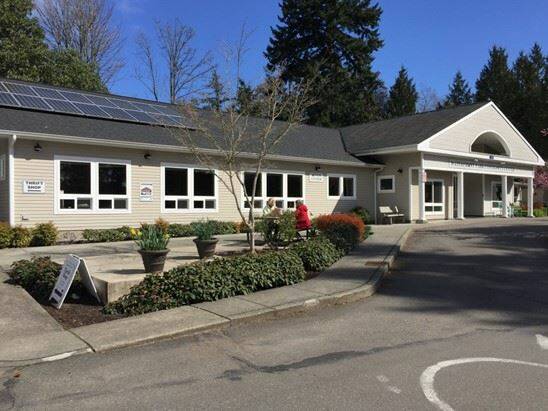The Bainbridge Island City Council checked in with four ongoing projects during its study session July 16.
First, councilmembers heard a planning update from officials with the Bainbridge Island Senior Center, which is slated for a major retrofit in the next five years. Out of three proposed options — A) total replacement of the existing building, or B) and C) partial replacement of the existing building, with an addition wrapping around the structure on either the west or east side — BISC favors the former. Option A meets nearly all the priorities for new construction determined by BISC and other community members, and accommodates more space for an additional priority stipulated by the city: new senior housing.
Architect Charlie Wenzlau presented updates to plans that include two new four-story housing complexes adjacent to the retrofitted senior center, both of which would contain about 28 one-bedroom units per building. All new construction would include parking, in the form of underground garages and some surface lots, but the amount of space dedicated to parking is not yet finalized.
“I think there’s a huge possibility for residents to be there and not need parking at all, because it is so incredibly centrally located. And, you’re likely to have residents who won’t be able to drive,” councilmember Leslie Schneider said. “Has there been any thought to sharing after-hours use of the senior center parking area?”
BISC executive director Reed Price responded, saying that currently, the senior center building does not meet the needs of the community, and the proposed changes would present an opportunity to serve more than just seniors, but the purpose of the proposal should be focused on the community center.
“Our goal with this is to assure you that the city has ample space to move forward with a colocated housing complex. The senior community center is not really tasked, or capable of, launching a housing project,” Price said.
Next, the city council heard a presentation that detailed the effects of sea level rise on city-owned assets around the island. Lindsey Sheen, environmental planner, walked councilmembers through the potential realities that could manifest, as oceans reach up to two feet higher by 2060 and five feet and beyond by 2100. But depending on whether emissions are curbed, increased, or leveled off, the actual rate of sea level rise is hard to predict, Sheen explained.
“We know sea level rise is happening, but we don’t know how much and by when,” she said. “What we do to hedge our bets is assess assets with ‘bookends’ — an extreme and conservative estimate to understand the risks for each site.”
BI has over 50 miles of marine shoreline, and areas that flood now will flood more frequently with deeper waters. Sheen’s report found that based on emissions rates today, some roads in Eagle Harbor, Lynwood, Yeomalt, Manitou Beach, Hawley Cove, Pt. White and Crystal Springs will all flood annually by 2060, which can limit emergency response services, and damage facilities and private property. Additionally, rising groundwaters can impact drainage during storms, which can lead to more flooding.
City councilmembers Joe Deets and Clarence Moriwaki expressed gratitude to Sheen for the report and called for more public awareness of the imminent issues.
Third, the council heard broad updates on the Winslow Subarea and Comprehensive Plan that explained the timeline for outreach and broke down the potential changes to each island neighborhood center into three categories: build it up, build it out, or leave it as-is. Patty Charnas, city planning director, expressed excitement about the committee’s first islandwide public input campaign: a postcard sent to every single address on the island by July 26 that explains how to access the drafts of neighborhood plans and environmental impact reports.
“We are at the precipice of a step that we have been waiting for and working on for a long time,” Charnas said. “These are all concepts; changes are only as needed in our neighborhood centers. If the public is overwhelmingly against change, which we don’t expect, the growth still goes somewhere. That’s why we are looking at complementary alternatives.”
Finally, the council looked at ways to proceed with a new form of localized public transit: a city-run “circulator”, or a fixed transit route that runs within a closed loop. City manager Blair King explained that because there are still a number of unknowns — such as system capacity, service area, conflicts between existing transportation, fare structures and so on — there must be an information-gathering step before any action is taken. The city could choose to run a gap analysis for $30,000, which would answer most of the questions, or refer the program to either the transportation subcommittee or the island Comprehensive Plan.
The council will revisit the proposal after budget discussions later this year.


